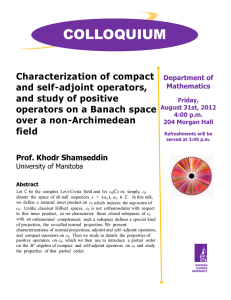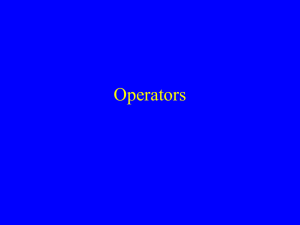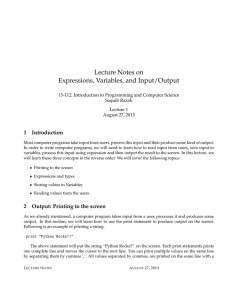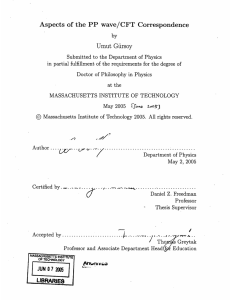PYTHON VARIABLES : CHAPTER 2 FROM THINK PYTHON
advertisement
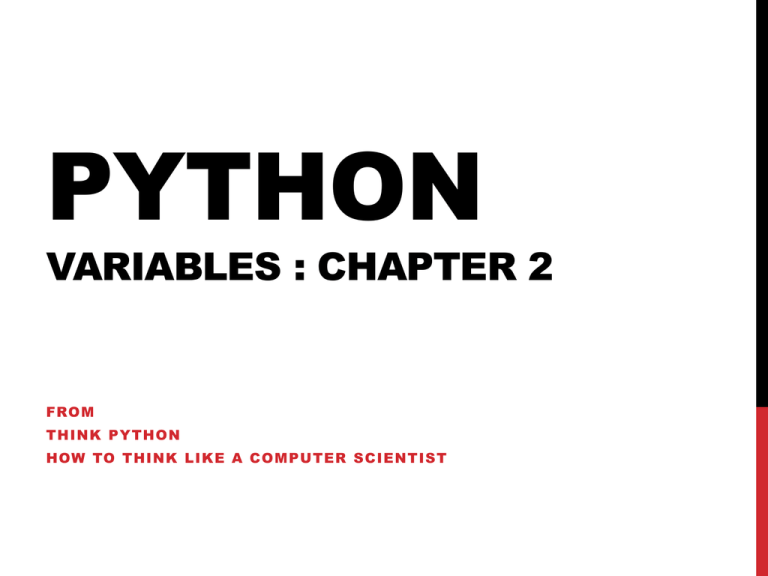
PYTHON VARIABLES : CHAPTER 2 FROM THINK PYTHON HOW TO THINK LIKE A COMPUTER SCIENTIST VALUES AND TYPES A value is one of the basic data objects that a Python program works with. Two of the most used values are numbers and strings of letters. These values are categorized into types which include numbers(float, integer, string) Examples: 23 is an integer 3.14159 is a floating point (float for short) ‘Hello World!’ is a string of characters >>> print 23, 3.14,’This is a cool class’ 23 3.14 This is a cool class TYPE() FUNCTION There is a function called type() that will give you (return) the type of a value. >>>type(23) <class ‘int’> >>>type(3.456) <class ‘float’> >>>type(‘Hello’) <class ‘str’> >>>type(‘45’) <class ‘str’) Note this one!!!! VARIABLES A variable is a name that refers to a value. A assignment statement is the usual way to create variables and assign values to them. Here are a few examples N = 34 PI = 3.1415926535 Name = ‘Richard Simpson’ The type of a variable is the type of the value it is assigned to. For example >>>type(PI) <class ‘float’) Note: if you change the value to a different type its type will change also! VARIABLE NAMES • Variables names can be arbitrarily long. • The can contain numbers and letters and underscore. • Upper and lower case is acceptable. • A variable name cannot start with a number • Keywords are not allowed. These include • And, as, break, if, else, elif, for, from, import, in, not, or, return, while with, as well as some others. STATEMENTS A statement (instruction) is a unit of code that the interpreter can execute. At this point we have only seen two statements, the print statement and the assignment statement. These are executed one at a time in the interactive mode. A script, ie as sequence of instructions, will also execute one at a time but much faster. Here is a script print 34 x=4 Print x There are many other statements that we shall learn OPERATORS AND OPERANDS Operators are used to construction expressions The usual mathematical operators such as +, -, * and / should be quite familiar to you. Here are some example expressions 2+3 7+4*8 #what is the result here? 3.24 + 5*(4.0-3.2) 8 – 2**3 4.0//3 # ** is the power (exponentiation) operator #divide and drop the decimal (floor division) 4/3 #also floor division. Result is 1 4.0/3 # result here is 1.3333333333333333 EXPRESSION EVALUATION IN INTERACTIVE MODE >>>2+2 4 >>> 4//3 1 >>> 34 % 3 # divide and return remainder (modulus) 1 >>>2*2**3 16 # ** has higher precedence than * ORDER OF OPERATIONS 1. Parentheses has the highest precedence 2. Exponentiation 3. Multiplication and Division 4. Addition and Subtraction 5. Operators of equal precedence are L to R PEMDAS >>> 2+4*3**2-5-10/2 gives what? STRING OPERATORS There are two operators that work on strings (+ and *) The + operators performs concatenation >>> ‘Soft’+’ware’ Software The * operators duplicates a string. For example >>> ‘Soft’*4 SoftSoftSoftSoft The others don’t work. COMMENTS Comments can be anywhere, but must follow # The interpreter will not read anything past the # symbol #This is a comment X=4 # so is this Start every program that you turn in with the following comment collection # Project # : Topic name # Your name # Explain what the program does EXERCISES Assume that the following statements are executed Val = 10 Len =15.5 Spacer = ‘_’ What do the following valuate to? Val/3 Val/2.0 int(Len)*2 Spacer*10 Do exercise 2.4 page 16 (all three) and study glossary 2.11



